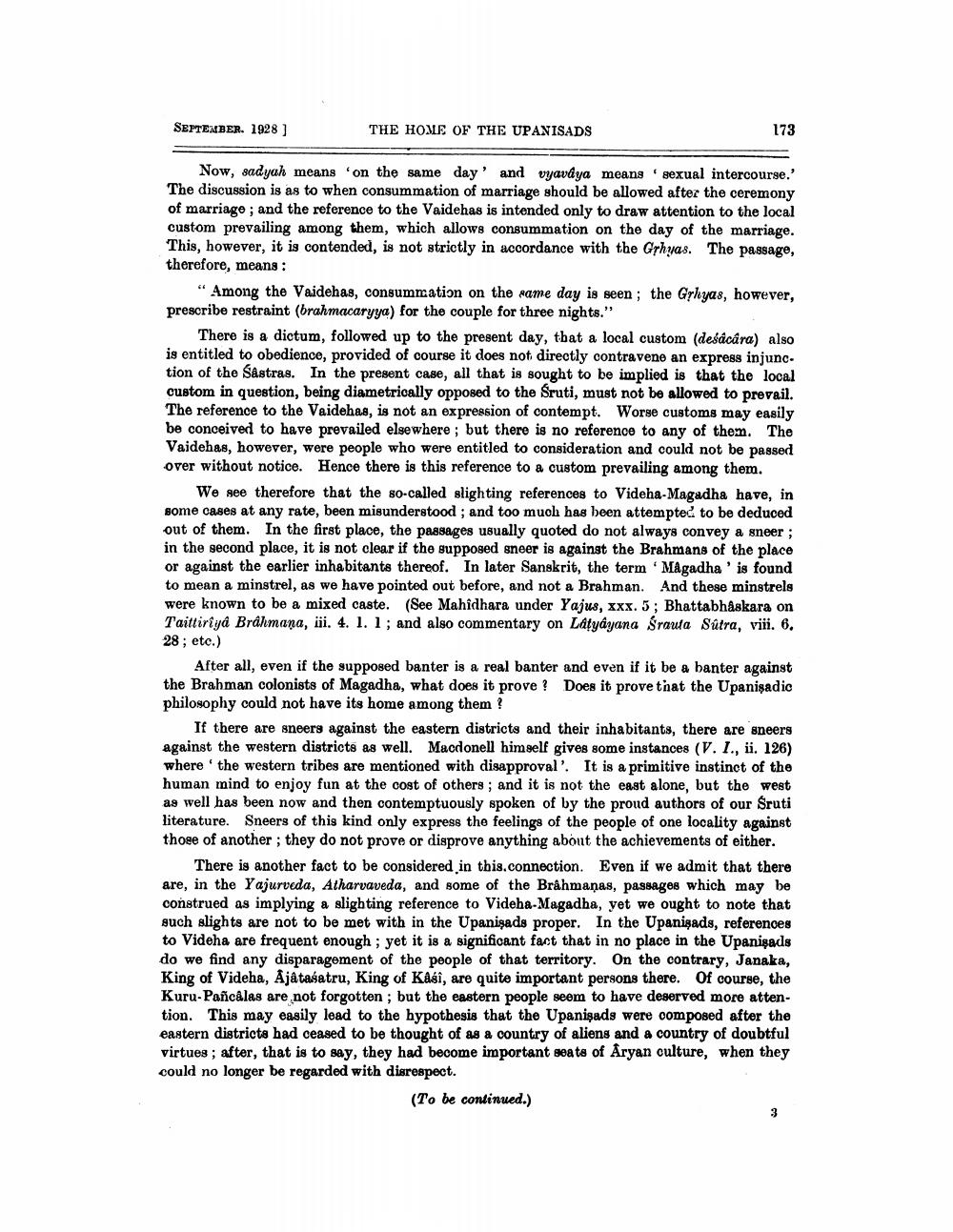________________
SEPTEMBER. 1928)
THE HOME OF THE UPANISADS
173
Now, sadyah means 'on the same day' and vyavdya means sexual intercourse.' The discussion is as to when consummation of marriage should be allowed after the ceremony of marriage, and the reference to the Vaidehas is intended only to draw attention to the local custom prevailing among them, which allows consummation on the day of the marriage. This, however, it is contended, is not strictly in accordance with the Grhyas. The passage, therefore, means :
"Among the Vaidehas, consummation on the same day is seen; the Grhyas, however, prescribe restraint (brahmacaryya) for the couple for three nights."
There is a dictum, followed up to the present day, that a local custom (desacára) also is entitled to obedience, provided of course it does not directly contravene an express injunc. tion of the Sastras. In the present case, all that is sought to be implied is that the local custom in question, being diametrically opposed to the Sruti, must not be allowed to prevail. The reference to the Vaidehas, is not an expression of contempt. Worse customs may easily be conceived to have prevailed elsewhere ; but there is no reference to any of them. The Vaidehas, however, were people who were entitled to consideration and could not be passed over without notice. Hence there is this reference to a custom prevailing among them.
We see therefore that the so-called slighting references to Videha-Magadha have, in some cases at any rate, been misunderstood ; and too much has been attempted to be deduced out of them. In the first place, the passages usually quoted do not always convey a sneer ; in the second place, it is not clear if the supposed sneer is against the Brahmans of the place or against the earlier inhabitants thereof. In later Sanskrit, the term Magadha' is found to mean a minstrel, as we have pointed out before, and not a Brahman. And these minstrels were known to be a mixed caste. (See Mahidhara under Yajus, xxx. 5; Bhattabhaskara on Taittiriyd Brâlimana, iii. 4. 1. 1; and also commentary on Latyayana Srauta Sútra, viii. 6. 28 ; etc.)
After all, even if the supposed banter is a real banter and even if it be a banter against the Brahman colonists of Magadha, what does it prove? Does it prove that the Upanişadic philosophy could not have its home among them?
If there are sneers against the eastern districts and their inhabitants, there are sneers against the western districts as well. Macdonell himself gives some instances (V. I., ii. 126) where the western tribes are mentioned with disapproval'. It is a primitive instinct of the human mind to enjoy fun at the cost of others; and it is not the east alone, but the west as well has been now and then contemptuously spoken of by the proud authors of our Sruti literature. Sneers of this kind only express the feelings of the people of one locality against those of another; they do not prove or disprove anything about the achievements of either.
There is another fact to be considered in this.connection. Even if we admit that there are, in the Yajurveda, Atharvaveda, and some of the Brahmanas, passages which may be construed as implying a slighting reference to Videha-Magadha, yet we ought to note that such slights are not to be met with in the Upanişads proper. In the Upanişads, references to Videha are frequent enough ; yet it is a significant fact that in no place in the Upanişads do we find any disparagement of the people of that territory. On the contrary, Janaka, King of Videha, Ajátasatru, King of Kasi, are quite important persons there. Of course, the Kuru-Pañcâlas are not forgotten; but the eastern people seem to have deserved more attention. This may easily lead to the hypothesis that the Upanigads were composed after the eastern districts had ceased to be thought of as a country of aliens and a country of doubtful virtues ; after, that is to say, they had become important seats of Aryan culture, when they could no longer be regarded with disrespect.
(To be continued.)




